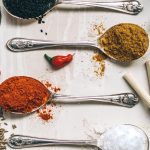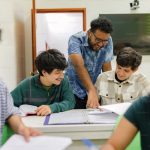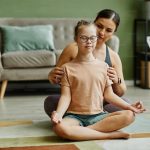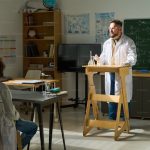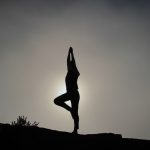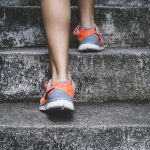Chaanah Mortlock is the founder of Curvy Asanas Yoga, which is for curvy minds as well as curvy bodies. After a motorbike accident left her unable to compete as a kickboxer, run half marathons and practice the other sports she loved, she turned to yoga. Through a process of trial and error, yoga helped her find wellbeing, focused her mind, and reduced her stress levels. After being diagnosed with various neurodivergent conditions, her mission is to create yoga classes that are genuinely open and safe spaces for all to gain the benefits of yoga.
1. Before you found yoga you were a kickboxer – how did you get into that?
I’ve been married to my husband for twenty years now. He is the most amazing person who has allowed me to be me, and has supported me all the way. But before I met him, I had a violent partner who abused me physically, emotionally and psychologically.
My brother is a competitive kickboxer, and I thought it would be a good way to stand up for myself, so that I would never be in that position again. It was hard to start with and I had to get over how I used to feel. But then I got into it, and I used to train in the garage. Afterwards I would feel elated and full of it.
Before I couldn’t kickbox any more I had come fourth in the Nationals and was preparing for my black belt.
2. What brought your kickboxing journey to an end?
Sadly my husband and I had to put everything on hold to care for my father who had cancer. Before that I used to practice four or five times a week.
3. You were also a keen runner – how did that come about?
I used to run when I was training for kickboxing and when Dad was poorly I carried on. It was thinking space, where I could absorb what was going on, and think about the good times. It was hard then as every time we saw Dad there was a little less of him, like a sandcastle being taken by the incoming tide. He was my adoptive father and he was a very special man.
I did half marathons and was preparing for my first full marathon – the Brighton marathon – when I had my motorbike accident, and after that everything stopped.
4. Tell us about your motorbike accident.
The accident was on the day of my motorbike test. I was coming out of the test centre in Kettering and a woman pulled out and hit me. I went up over the bonnet and landed on the other side of the road. The doctors said I was actually very lucky, as I could easily have broken my spine. As it is I have a soft spot in my spine, so I have to be careful. The result of my accident was that I could no longer do any high intensity sports, including kickboxing and running.
After my accident I hit a low patch. I was on anti-depressants, gained weight and fell apart really. I was angry as I felt everything had been taken away, and that I had had no choice in the matter. I had had previous issues with eating and I didn’t know what to do.
5. How did you find yoga classes after your accident?
I was told by various doctors and physiotherapists to do yoga or pilates, but back then I thought of yoga as being an old lady sport. I tried Pilates but found it wishy washy and faffy, and personally I got nothing from it.
I then tried yoga classes, but I struggled with the comments. I am a bigger girl and everyone else seemed to be skinny in tiny bra tops. I tried different classes and in one class a teacher pushed me quite roughly to get my hands to hold in Marichyasana. It was uncomfortable, both physically and emotionally. I felt all the attention was on me, and not in a good way. She told me that if I kept coming I would become more flexible. I stopped going.
6. That doesn’t sound great! What was the next step?
I then tried yoga online – at least I couldn’t be touched and pushed online.
I tried Yoga with Adriene, but I found it hard to motivate myself. So I signed up for an app, Asana Rebel, and got into practising every day. I used to build up a sweat and I thought, I can do this. At the time I was on the anti-depressants.
After a year I began to feel different. I also started meditating, also using an app. I tried classes again, and I did start to notice a change in my body and my mental state. I decided I wanted to learn more about yoga and about my body.
7. What made you decide to become a yoga teacher?
When I decided to learn more about yoga I came across YogaLondon and I booked onto the Foundations Course, taught by Jonathan Thompson. I loved it. There was another bigger girl on the course and I thought – this is cool. I then signed up for the 200-hour course, with no intention to teach, but again to learn more about my body and yoga. I felt that something was happening to my body through yoga and I wanted to know how.
Halfway through the course we were encouraged to teach and I started to become more flexible, as well as lose a little weight. However, I realised then that becoming more flexible was nothing to do with losing the weight, they were two separate things.
By the end of the course I realised that I wanted to pass this on. I truly felt that I had been given a second chance and if I could give one other person that new lease of life that I felt, I felt it would be worth it.
8. What was the best thing about the 200-hour course?
Fra (Francesca Sanlorenzo) is an amazing woman and teacher – she’s beautiful inside and out. She is just so supportive and helpful and encouraging all the way through.
At the time of my training I was also going through the process of getting my dyslexia diagnosis. She told me to trust the process, and was so accommodating. When I took my 200-hour exam I was terrified about learning the spelling of the Sanskrit pose names. But Fra said that as long as she could read what I’d written phonetically it didn’t matter. I also drew things to explain how I was feeling, as I’m better with pictures than writing.
The yoga family you build around you from the other course students was also very supportive.
9. Did you go on to teach after your 200-hour training?
My first business was Asana108. But then I was diagnosed not only with dyslexia, but also dyscalculia, ASD (Autistic Spectrum Disorder), and ADHD (Attention Deficit Hyperactivity Disorder). It was hard to get my head around it. It did make sense though as when I was studying with YogaLondon I found it immensely challenging.
I began to understand myself and realise that there are so many others out there with this combination. They don’t realise that yoga would give them anything, but I wanted to show them how well they could feel.
10. What further training did you do to help you with your mission?
Late last year I started my 500-hour teacher training as a way to grow myself. I wanted to do this as a way to teach bigger people like me. Looking at magazines there was nothing representing larger women, it’s all skinny women. Regardless of colour, race, age, sexuality, I wanted to show that yoga is for every body on this earth.
I’ve also started a Special Yoga course, learning to teach peopled with special educational needs. I struggle with noise and I can’t always listen to certain voices, it’s not disrespectful or rude, it’s a real issue. Also I struggle if the light is too bright.
There are lots of sensory challenges for people like me and I want to offer solutions to that. In my new place we’re going to have a studio in the garden, which can have lots of options, in terms of light levels, smell, sound and so on.
11. What’s your long-term yoga teaching goal?
Last year I started Curvy Asanas Yoga for curvy bodies and curvy minds. Neurodivergent people are very different and think outside the box, and I really want to grow that.
Two weeks ago I had my first one to one client, who was very scared to attend regular yoga classes. She found me online and was amazed as she didn’t realise something like this existed. She has now signed up for a set of six lessons and says she’s never been made to feel so welcome. She she’s my one person helped. Job done!
But it would be great to spread my message and that’s my mission.


